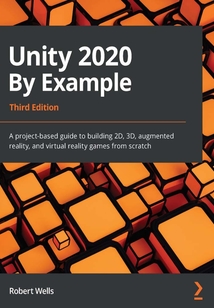舉報(bào) 

會(huì)員
Unity 2020 By Example
最新章節(jié):
Other Books You May Enjoy
TheUnitygameengine,usedbymillionsofdevelopersaroundtheworld,ispopularthankstoitsfeaturesthatenableyoutocreategamesand3Dappsfordesktopandmobileplatformsinnotime.WithUnity2020,thisstate-of-the-artgameengineintroducesenhancementsinUnitytooling,editor,andworkflow,amongmanyotheradditions.ThethirdeditionofthisUnitybookisupdatedtothenewfeaturesinUnity2020andmoderngamedevelopmentpractices.Onceyou’vequicklygottogripswiththefundamentalsofUnitygamedevelopment,you’llcreateacollection,atwin-stickshooter,anda2Dadventuregame.You’llthenexploreadvancedtopicssuchasmachinelearning,virtualreality,andaugmentedrealitybybuildingcompleteprojectsusingthelatestgametoolkit.Asyouimplementconceptsinpractice,thisbookwillensurethatyoucomeawaywithaclearunderstandingofUnitygamedevelopment.Bytheendofthebook,you'llhaveafirmfoundationinUnitydevelopmentusingC#,whichcanbeappliedtootherenginesandprogramminglanguages.You'llalsobeabletocreateseveralreal-worldprojectstoaddtoyourprofessionalgamedevelopmentportfolio.
目錄(165章)
倒序
- 封面
- 版權(quán)信息
- Why subscribe?
- Contributors About the author
- About the reviewers
- Packt is searching for authors like you
- Preface
- Who this book is for
- What this book covers
- To get the most out of this book
- Download the example code files
- Download the color images
- Conventions used
- Get in touch
- Reviews
- Chapter 1: Exploring the Fundamentals of Unity
- Technical requirements
- Exploring new features in Unity 2020
- Introducing the first game
- Starting a level
- Testing the game
- Improving the scene
- Saving the scene
- Summary
- Test your knowledge
- Further reading
- Chapter 2: Creating a Collection Game
- Technical requirements
- Working with Materials
- Scripting in Unity
- Recording the total coin count
- Working with prefabs
- Creating a timer
- Playtesting
- Building the game
- Summary
- Test your knowledge
- Further reading
- Chapter 3: Creating a Space Shooter
- Technical requirements
- Looking ahead – the completed project
- Starting the project
- Importing assets
- Creating the player object
- Configuring the cameras
- Creating a Health component
- Creating the explosive particle system
- Creating the enemy object
- Spawning enemies
- Summary
- Test your knowledge
- Further reading
- Chapter 4: Continuing the Space Shooter Game
- Technical requirements
- Creating the projectile system
- Customizing controls
- Creating the score system
- Adding the final touches
- Summary
- Test your knowledge
- Further reading
- Chapter 5: Creating a 2D Adventure Game
- Technical requirements
- Getting started
- Configuring the game view
- Creating an environment
- Adding post-processing effects
- Implementing environmental physics
- Creating a 2D player
- Moving the player
- Optimizing using sprite packing
- Summary
- Test your knowledge
- Further reading
- Chapter 6: Continuing the 2D Adventure
- Technical requirements
- Constructing additional scenes
- Implementing moving platforms
- Implementing player kill zones
- Creating the UI health bar
- Summary
- Test your knowledge
- Further reading
- Chapter 7: Completing the 2D Adventure
- Technical requirements
- Adding gun turrets
- Creating an NPC
- Implementing a quest system
- Summary
- Test your knowledge
- Further reading
- Chapter 8: Creating Artificial Intelligence
- Technical requirements
- Looking ahead – an overview of the project
- Importing assets
- Constructing the terrain
- Generating the navigation mesh
- Implementing the NPC
- Testing navigation
- Animating the NPC
- Patrolling the environment
- Entering the world
- Summary
- Test your knowledge
- Further reading
- Chapter 9: Continuing with Intelligent Enemies
- Technical requirements
- Providing the enemy with sight
- Implementing the FSM
- Patrolling the environment
- Chasing the player
- Attacking the player
- Summary
- Test your knowledge
- Further reading
- Chapter 10: Evolving AI Using ML-Agents
- Technical requirements
- Introducing ML-Agents
- Setting the scene
- Importing assets
- Installing ML-Agents
- Creating the environment
- Spawning objects
- Creating the Agent
- Training the Agent
- Embedding the model
- Summary
- Test your knowledge
- Further reading
- Chapter 11: Entering Virtual Reality
- Technical requirements
- Preparing the project
- Creating scene lighting
- Preparing for VR
- Test your knowledge
- Further reading
- Chapter 12: Completing the VR Game
- Technical requirements
- Spawning objects
- Creating the enemy
- Implementing a damage system
- Summary
- Test your knowledge
- Further reading
- Chapter 13: Creating an Augmented Reality Game Using AR Foundation
- Technical requirements
- Introducing the project
- Getting started with AR
- Creating an AR scene
- Placing an object in the world
- Testing on devices
- Implementing AR in the URP
- Summary
- Test your knowledge
- Further reading
- Chapter 14: Completing the AR Game with the Universal Render Pipeline
- Technical requirements
- Detecting planes
- Adding a placement marker
- Placing objects in the world
- Post-processing in the URP
- Summary
- Test your knowledge
- Further reading
- Other Books You May Enjoy 更新時(shí)間:2021-06-11 17:57:58
推薦閱讀
- Mastering OpenLayers 3
- C程序設(shè)計(jì)簡明教程(第二版)
- 編程的修煉
- C語言程序設(shè)計(jì)(第3版)
- SQL語言從入門到精通
- SEO智慧
- Learning Hunk
- 前端HTML+CSS修煉之道(視頻同步+直播)
- 深入剖析Java虛擬機(jī):源碼剖析與實(shí)例詳解(基礎(chǔ)卷)
- App Inventor創(chuàng)意趣味編程進(jìn)階
- Python商務(wù)數(shù)據(jù)分析(微課版)
- 單片機(jī)原理及應(yīng)用技術(shù)
- ASP.NET求職寶典
- Training Systems Using Python Statistical Modeling
- Android Sensor Programming By Example
- 大學(xué)計(jì)算機(jī)基礎(chǔ)實(shí)訓(xùn)教程
- C語言程序設(shè)計(jì)與應(yīng)用實(shí)驗(yàn)指導(dǎo)書(第2版)
- Java語言程序設(shè)計(jì)實(shí)用教程(第2版)
- Spring Web Services 2 Cookbook
- 零基礎(chǔ)學(xué)Java(升級(jí)版)
- C++ Game Development Cookbook
- Python服務(wù)端測(cè)試開發(fā)實(shí)戰(zhàn)
- JavaScript高級(jí)程序設(shè)計(jì)(第3版)
- Spring Cloud微服務(wù)架構(gòu)開發(fā)實(shí)戰(zhàn)
- 物聯(lián)網(wǎng)及低功耗藍(lán)牙5.x高級(jí)開發(fā)
- Java程序員職場全攻略
- Beginning C++ Programming
- Visual Basic數(shù)據(jù)庫開發(fā)全程指南
- Learning SAP BusinessObjects Dashboards
- Web Development with Django Cookbook(Second Edition)

